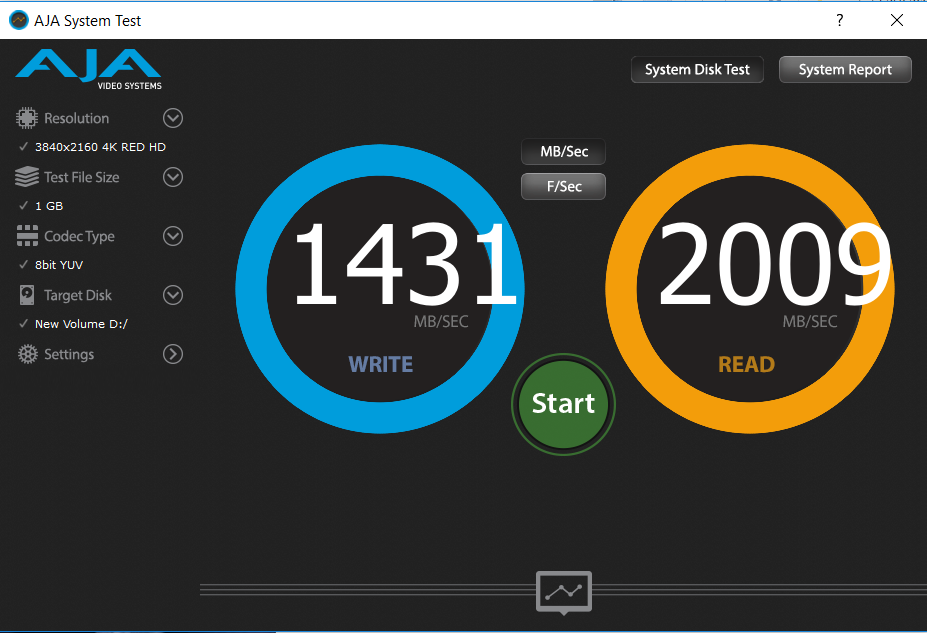AJA VIDEO SYSTEM DISK TEST
The AJA Video Systems Disk Test is relatively new to our testing and tests the transfer speed of video files with different resolutions and Codec.
TxBench is one of our newly discovered benchmarks that we works much the same as Crystal Diskmark, but with several other features. Advanced load benchmarking can be configured, as well as full drive information and data erasing via secure erase, enhanced secure erase, TRIM and overwriting. Simply click on the title for a free copy.
SSD Maintenance and performance enhancements are available through download of Crucial’s SSD Storage Executive by clicking on the link through the title above. This software package is one of the better SSD tools we have come across and includes such things as the ability to sanitize the SSD, increase performance through Momentum Cache, or even adjust over-provisioning.
REVIEW ANALYSIS AND FINAL THOUGHTS
Considering the price point Crucial established for the Crucial P2, it’s a shame they limited capacities to 250 and 500GB. I understand their direction as they were aiming straight for those making the SSD transition, but it would have been great to see 1/2TB pricing for the P2. The SSD has value, a 5-year warranty and performance is what can be expected for an entry level SSD of this caliber, 2100MB/s read and 1800MB/s write.
As for any benchmark anomalies, it sometimes occurs where a certain SSD doesn’t quite give us what we want from that software. And that is why we include several programs. Overall, however, the SSD appears to be a decent entry level SSD from a very reliable company, and the software that goes along with it is very well put together.
 The SSD Review The Worlds Dedicated SSD Education and Review Resource |
The SSD Review The Worlds Dedicated SSD Education and Review Resource | 


The flash is QLC, not TLC.
The ‘E’ in this number ‘MT29F1T08EMHAFJ4-3R:B’ which is drawn from the FBGA code NX959 designated TLC as listed in this part numbering decoder:
https://dtsheet.com/doc/1384381/nand-flash-part-numbering-system
A request for clarification has been sent off to Micron but I would like to hear your reasoning.
I think that you are right. I always thought that P2 was a P1 with a new generation of QLC NAND, just like Intel 660p -> 665p. The simple facts that it is not the SMI controller and there is no DRAM should make it a TLC drive. Sorry for the confusion.
The 500GB SKU is rated as 96L QLC but currently it’s using TLC.
Yes. That is why we believe that the performance is underrated with 960MB/s write…in anticipation of.
Nope… that’s ok. been known to slip every now and then as well. I think that’s how i retain readership…
I still don´t own a NVME-SSD and I don´t know if I´m the only one in the world which use the capacity of SSD.
But after tried some actual SSD-drives with 1TB and 2TB (less is senseless for me, have enoght of smaller SSDs) I´m annyoed about the “performance” of the SSDs. My ten years old HDDs beat some of these SSDs if I fill the capacity.
So a review without a squential write test of whole capacity is useless for me, sorry.
I apologize in advance but your comparison between the HDD and SSD is not physically possible. There is no way possible that a HDD can come anywhere near close to the start times and typical operations of a PC, simply because of the massive difference in seek time. The SSD is .01ms compared to any typical HDD a 9ms. We appreiate your comment in any case; this is an entry level SSD and the only really fair comparison might be to any HDD.
How would this drive compare to streaming a game from something like the mx500 SSD drive? I wonder about getting one of these just to be able to have some game streaming capacity in something like Star Citizen. These just seem very cheap to get into the NVMe game but maybe the low read speeds at smaller file sizes is a deal breaker?
I am not an expert on gaming but streaming, for the most part, relies on seek time which is much the same for most SSDs. The key to gaming and SSDs is scene transition as the scene is loaded into RAM which puts more of the concern on CPU and RAM. When I speak of SSDs such as the P2 and the ADATA Swordfish, both of which we just reported on, I would put them more in the hard drive to SSD transition category and leave them there…typical system operation. Stay tuned for my next review this week on the Kingston KC2500. This is a dynamite SSD and perhaps one of the best on the market for PCIe 3 right now.
Really like the improvements to the site.
Been with you since the XP941 days.
Ready for new Vermeer builds this year, your reviews will help again.
Great hearing from you James.